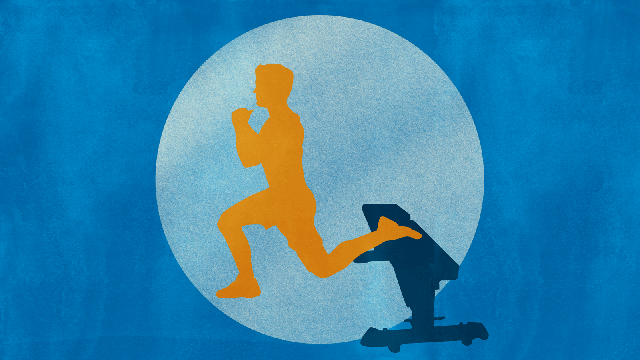It’s squat day, and you’re excited to show that barbell who’s boss, but there’s just one problem: The squat racks are all taken. You can be a good team player and ask to work in, or you can try these squat variations you can do without a squat rack (and in some cases, without a gym at all).
Illustration by Sam Woolley.
You don’t need to barbell back squat all the time to reap the many benefits of squatting. Getting strong and proficient in some of these exercises can actually help your barbell back squat, too. It’s a win-win.
Chair Squat
You can use a bench or any slightly-above-knee-height platform if there’s no chair available. The chair squat teaches you to sit back in a squat and also caters to people who can’t quite get low enough yet for a full bodyweight squat. Push into the ground with your heels when you come back up.
Goblet Squat
The goblet squat is one of my favourite exercises, and I do them regardless of whether the squat rack is hogged up. Not only does it strengthen your upper back and core, the goblet squat is a good way to teach yourself the squat pattern and can improve your squat itself. The video above by Girls Gone Strong uses a kettlebell as her counterweight, but you can just as easily use a dumbbell. Just turn it vertically and clutch it from the top. Hold the weight close to your chest and keep your upper back tight as you squat straight down.
Bulgarian Split Squat
A Bulgarian split squat will beat the snot out of your single-leg strength, balance and stability. It’s also called the rear-foot elevated split squat because you prop your rear foot on a bench behind you and then squat down, leaning slightly into your front leg. Because of that, you need fairly flexible hip flexors and ankles to make the exercise feel less awkward. Don’t be surprised to find that doing the exercise is harder on one leg than the other — we all have asymmetrical quirks like that!
Pistol Squat
The pistol squat is as impressive as it sounds. If you can pull it off in its full range of motion, you have praiseworthy strength and control of your hip muscles, as well as some bulletproof knees and ankles. It’s not an easy exercise, and chances are, you’ll need to take baby steps toward the full pistol squat. Partial reps like sinking into a chair squat on one leg, for example, can help.
Suspension Trainer-Assisted Pistol Squat
Holding onto suspension trainer straps for support makes learning the pistol squat easier. You can go deeper and gradually develop the control and strength you need to power yourself back up.
Weighted Jump Squat
You can do jump squats with or without weights. The beauty of jump squats is that they’re simple, but also, regular jump squat training can develop your ability to power through weak spots in your squat. If you have grumpy knees, you can explode back up without your toes ever losing contact with the ground or avoid this one altogether.
Box Jump
A proper box jump is about landing softly atop the box at around a parallel-level squat, not tucking in your knees as much as possible to clear a really high box. It’s important to note, too, that when you do box jumps you don’t do them as fast as possible. Some people do, and I get a little squeamish when I imagine them eating it or bloodying their shins. Again, this isn’t an exercise for people with knee troubles.
Isometric Squat
An isometric squat is holding the bottom half of the squat position for as long as possible. Even though you’re not moving, you’re still working your muscles really hard. If holding it without any support is too much for you to currently handle, you can try an isometric squat against the wall or an exercise ball.
Jefferson Squat
The Jefferson squat, also called the Jefferson deadlift, is in a league of its own. It looks bizarre and makes you wonder, How on earth does this work? David Dellanave, a strength coach and huge advocate of the Jefferson squat, says:
One of the neat things about the Jefferson lift is that it’s already so weird and awkward, it’s impossible for anyone to pin down what “perfect form” is for it. As such, people default to finding what actually is the strongest leverage for their own body.
Dellanave’s article on Jefferson squats, in addition to the video above, gives you some tips to help you find a comfortable starting and finishing position. And best thing about this exercise? You don’t need a squat rack.

Comments